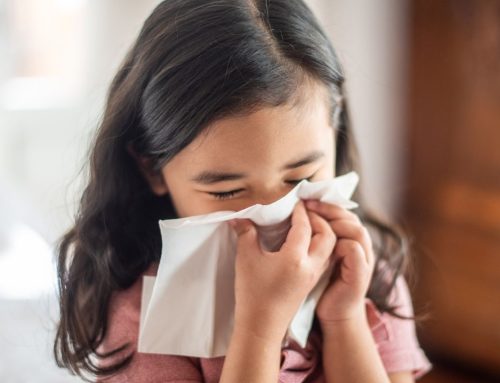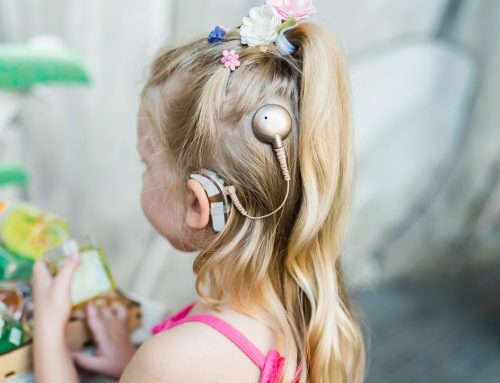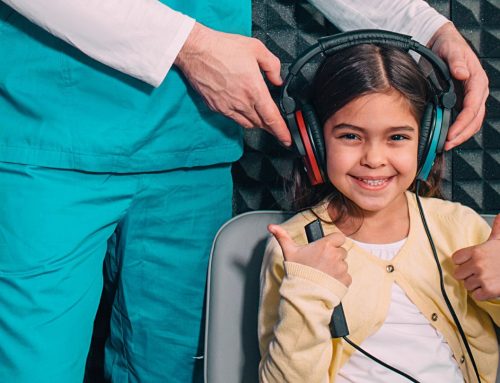Nosebleeds in children can be alarming, but they’re usually not a cause for serious concern. Understanding the common causes can help parents manage the situation calmly and even prevent future occurrences. In this blog, we’ll explore the reasons behind nosebleeds in kids, when to seek medical attention and tips to keep them at bay.
Key Takeaways
- Nosebleeds in children are commonly caused by factors such as nasal trauma, dry air, nasal congestion from colds or allergies, and irritants like smoke.
- Parents can effectively manage nosebleeds at home by keeping the child calm, applying pressure to the nose, and using humidifiers to maintain moisture in the air.
- Frequent or severe nosebleeds may indicate underlying medical conditions, necessitating consultation with a pediatric ENT specialist for proper diagnosis and treatment.
Common Causes of Nosebleeds in Children
While it may be startling, nosebleeds in children typically stem from a handful of usual suspects that are readily manageable once they’ve been pinpointed. Knowledge of these triggers is key to both preventing and handling nosebleeds effectively.
Children often experience nosebleeds due to nasal injuries, which can result from various activities such as playing sports or simply bumping their faces during playtime. Given the ample blood vessels present within the nasal area, even trivial mishaps can lead to noticeable bleeding.
The congestion associated with colds or allergic reactions plays another pivotal role in causing nosebleeds among kids. This build-up boosts pressure in the nasal passages and makes blood vessels more susceptible to bursting. Dryness of air, especially during colder seasons when indoor heating dries out environments, significantly contributes by desiccating the mucosal lining inside the nose—making it prone to cracking and subsequent bleeding incidents referred to as “nose bursts.”
Exposure to irritants like smoke or pungent scents exacerbates this condition. Persistent habits like forceful blowing of one’s nose or frequent picking also pose risks by directly injuring the sensitive internal surface layer known as mucosa located within nostrils—an action leading up to manual trauma-induced bleeds. Acknowledging these prevalent factors marks an initial stride toward controlling and averting episodes involving bloody noses among youth.
Environmental Factors
The prevalence of nosebleeds in children can be largely influenced by their surrounding environment. Dry air stands out as a primary environmental factor that exacerbates this issue. When homes are heated during the winter season, it often results in lower humidity levels indoors, leading to drier nasal passages, which increase the risk of bleeding.
Implementing a humidifier within your living space is an effective strategy for preserving adequate moisture content in the atmosphere, thereby ensuring that the nasal lining remains moist and less prone to damage. The shift into colder seasons particularly amplifies instances of nosebleeds due to both external cold and internal heating creating dry conditions.
By maintaining an equilibrium of moisture inside homes, one can significantly curtail the frequency with which children experience nosebleeds and also help prevent them from occurring altogether.
Medical Conditions Leading to Nosebleeds
In children, while the majority of nosebleeds stem from benign causes, repeated or intense episodes may signal a more serious health issue that warrants attention. Parents should be vigilant and ready to seek medical advice when necessary.
Children may experience an increased incidence of nosebleeds due to specific anatomical conditions like a deviated septum, which can leave certain areas within the nasal cavity more susceptible to harm. Blood clotting disorders might contribute to recurrent and pronounced bleeding events in children by impairing the body’s ability to generate clots efficiently, causing even small wounds to result in excessive bleeding.
The use of particular medications known as anticoagulants is another factor that could elevate the risk of nosebleeds among children. These drugs diminish the capacity of blood for clot formation, thereby elevating the chances that minor injuries inside the nose lead to sustained bleeding. It is crucial for those caring for children with such medical issues to understand their influence on nasal bleeds so they can manage and help prevent future occurrences effectively.
When to Seek Medical Attention
Nosebleeds in children are often not caused by alarm and can typically be dealt with at home. Should your child exhibit severe symptoms like faintness, unconsciousness, or respiratory difficulties during a nosebleed, immediate medical attention is vital. In such scenarios, promptly visiting the nearest emergency room is recommended.
It’s also important to seek professional help if a child’s nosebleed continues unabated for more than 20 minutes despite direct pressure being applied. Signs that might indicate excessive bleeding include an unusual pallor or perspiration. These, too, necessitate an urgent trip to the pediatrician or emergency room.
Consulting a pediatric ENT (ear, nose, and throat) specialist may be necessary for those children who experience frequent or intense nosebleeds. Such specialists possess the expertise needed to determine any underlying health conditions and offer sophisticated treatments as required. Understanding when it’s time to get expert care plays a significant role in managing your child’s nosebleeds effectively.
Preventing Nosebleeds in Children
To mitigate the incidence of nosebleeds in children, it’s important to manage both their environment and behaviors. By ensuring that the air remains humid, especially when it’s dry outside, one can decrease the chances of a child experiencing a nosebleed. A practical way to achieve this is by placing a humidifier in your child’s room, which aids in keeping nasal passages from becoming too dry and consequently prone to bleeding.
Discouraging children from putting foreign objects up their noses and maintaining short fingernails can help avoid injuries within the nostrils that might cause bleeding. The application of saline gels or antibiotic ointments inside the nostrils also supports moisture retention and preserves the healthiness of the nasal lining, thus diminishing the potential for blood loss.
Teaching kids to softly blow their noses without picking them contributes significantly to averting nosebleeds as well. These straightforward preventative steps play an essential role in safeguarding against harm to the nasal lining while simultaneously lessening episodes where children experience bleeds from their noses.
Specialized Treatments for Recurrent Nosebleeds
Children who suffer from frequent nosebleeds may need specialized care. An effective treatment is the cauterization of nasal blood vessels with silver nitrate, which is designed to address anterior bleeding by sealing off the affected vessels. The procedure can be carried out in a clinic or emergency room setting and depends on how well the child can cope with it.
Post-cauterization care often includes applying saline gels to aid healing within the nasal passages. When dealing with more difficult posterior bleeds, it might be necessary to employ nasal packing to help control the bleeding.
Pediatric ENT experts are equipped to administer these targeted treatments, which are instrumental in stopping recurrent episodes of nosebleeds and preventing them from reoccurring in children.
Importance of Consulting Pediatric ENT Specialists
It is essential for children who suffer from frequent or intense nosebleeds to seek the expertise of pediatric ENT specialists. These professionals possess specialized knowledge that allows them to uncover and address root causes that may elude general practitioners. Employing sophisticated diagnostic instruments and methodologies, they can conduct thorough assessments and create customized treatment strategies for every individual child.
Securing the services of pediatric ENT specialists guarantees superior care for affected children. They are equipped with cutting-edge treatment alternatives as well as comprehensive aftercare support, ensuring not only successful management of nosebleeds but also promoting the sustained well-being of the child.
Final Thoughts
Understanding what causes nosebleeds in children and how to manage them is key to keeping your child healthy and comfortable. By identifying common triggers like nasal injuries, dry air, or potential underlying health conditions, parents can take proactive steps to prevent frequent occurrences. Equally important is knowing when professional help is necessary to address persistent or severe nosebleeds.
If your child is experiencing frequent nosebleeds or you have concerns about pediatric ear, nose, and throat health in Atlanta, we are here to help. We at Pediatric Ear Nose and Throat of Atlanta, P.C., are a compassionate team dedicated to guiding families through effective care solutions. Contact us today to learn more about how we can support your child’s health and well-being.
Frequently Asked Questions
What are the common causes of nosebleeds in children?
Nosebleeds in children are often caused by nasal trauma, dry air, congestion from colds or allergies, and frequent nose-picking or blowing.
Addressing these factors can help reduce the occurrence of nosebleeds.
When should I seek medical attention for my child’s nosebleed?
You should seek medical attention for your child’s nosebleed if it lasts longer than 20 minutes, is accompanied by severe symptoms, or if your child looks unusually pale or sweaty.
Prompt action is essential in these situations.
What preventive measures can reduce the frequency of nosebleeds in children?
To reduce the frequency of nosebleeds in children, maintain a humid environment, discourage nose-picking, keep fingernails trimmed, and apply saline gels or ointments to keep the nasal lining moist.
These simple measures can significantly help in prevention.
What specialized treatments are available for recurrent nosebleeds?
Specialized treatments for recurrent nosebleeds involve using silver nitrate to cauterize the nasal passages and, in severe cases, implementing nasal packing.
For advanced care regarding nosebleeds, seeking consultation from a pediatric ENT specialist is recommended.











